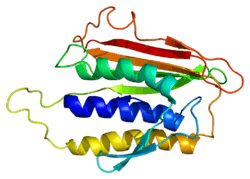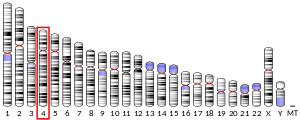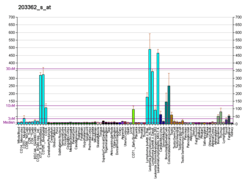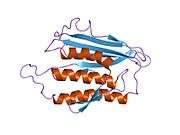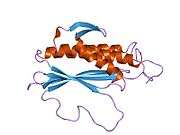MAD2L1
Mitotic spindle assembly checkpoint protein MAD2A is a protein that in humans is encoded by the MAD2L1 gene.[4][5][6]
Function
MAD2L1 is a component of the mitotic spindle assembly checkpoint that prevents the onset of anaphase until all chromosomes are properly aligned at the metaphase plate. MAD2L1 is related to the MAD2L2 gene located on chromosome 1. A MAD2 pseudogene has been mapped to chromosome 14.[6]
Interactions
MAD2L1 has been shown to interact with:
gollark: I use a 3-year-old business-y one I got cheaply refurbished.
gollark: Well, apparently people want mildly thinner laptops and/or don't care.
gollark: Some newer ones are STUPID and solder those in so you can't even upgrade those.
gollark: Laptops will generally not let you upgrade anything more than the RAM and disk(s).
gollark: Also those are quite slow and bad.
References
- GRCh38: Ensembl release 89: ENSG00000164109 - Ensembl, May 2017
- "Human PubMed Reference:". National Center for Biotechnology Information, U.S. National Library of Medicine.
- "Mouse PubMed Reference:". National Center for Biotechnology Information, U.S. National Library of Medicine.
- Li Y, Benezra R (October 1996). "Identification of a human mitotic checkpoint gene: hsMAD2". Science. 274 (5285): 246–8. doi:10.1126/science.274.5285.246. PMID 8824189.
- Xu L, Deng HX, Yang Y, Xia JH, Hung WY, Siddque T (November 1997). "Assignment of mitotic arrest deficient protein 2 (MAD2L1) to human chromosome band 5q23.3 by in situ hybridization". Cytogenet. Cell Genet. 78 (1): 63–4. doi:10.1159/000134631. PMID 9345911.
- "Entrez Gene: MAD2L1 MAD2 mitotic arrest deficient-like 1 (yeast)".
- Nelson KK, Schlöndorff J, Blobel CP (November 1999). "Evidence for an interaction of the metalloprotease-disintegrin tumour necrosis factor alpha convertase (TACE) with mitotic arrest deficient 2 (MAD2), and of the metalloprotease-disintegrin MDC9 with a novel MAD2-related protein, MAD2beta". Biochem. J. 343 (3): 673–80. doi:10.1042/0264-6021:3430673. PMC 1220601. PMID 10527948.
- Poghosyan Z, Robbins SM, Houslay MD, Webster A, Murphy G, Edwards DR (February 2002). "Phosphorylation-dependent interactions between ADAM15 cytoplasmic domain and Src family protein-tyrosine kinases". J. Biol. Chem. 277 (7): 4999–5007. doi:10.1074/jbc.M107430200. PMID 11741929.
- Sudakin V, Chan GK, Yen TJ (September 2001). "Checkpoint inhibition of the APC/C in HeLa cells is mediated by a complex of BUBR1, BUB3, CDC20, and MAD2". J. Cell Biol. 154 (5): 925–36. doi:10.1083/jcb.200102093. PMC 2196190. PMID 11535616.
- Zhang Y, Lees E (August 2001). "Identification of an overlapping binding domain on Cdc20 for Mad2 and anaphase-promoting complex: model for spindle checkpoint regulation". Mol. Cell. Biol. 21 (15): 5190–9. doi:10.1128/MCB.21.15.5190-5199.2001. PMC 87243. PMID 11438673.
- Sihn CR, Suh EJ, Lee KH, Kim TY, Kim SH (November 2003). "p55CDC/hCDC20 mutant induces mitotic catastrophe by inhibiting the MAD2-dependent spindle checkpoint activity in tumor cells". Cancer Lett. 201 (2): 203–10. doi:10.1016/s0304-3835(03)00465-8. PMID 14607335.
- Luo X, Fang G, Coldiron M, Lin Y, Yu H, Kirschner MW, Wagner G (March 2000). "Structure of the Mad2 spindle assembly checkpoint protein and its interaction with Cdc20". Nat. Struct. Biol. 7 (3): 224–9. doi:10.1038/73338. PMID 10700282.
- Sironi L, Melixetian M, Faretta M, Prosperini E, Helin K, Musacchio A (November 2001). "Mad2 binding to Mad1 and Cdc20, rather than oligomerization, is required for the spindle checkpoint". EMBO J. 20 (22): 6371–82. doi:10.1093/emboj/20.22.6371. PMC 125308. PMID 11707408.
- D'Angiolella V, Mari C, Nocera D, Rametti L, Grieco D (October 2003). "The spindle checkpoint requires cyclin-dependent kinase activity". Genes Dev. 17 (20): 2520–5. doi:10.1101/gad.267603. PMC 218146. PMID 14561775.
- Kallio MJ, Beardmore VA, Weinstein J, Gorbsky GJ (September 2002). "Rapid microtubule-independent dynamics of Cdc20 at kinetochores and centrosomes in mammalian cells". J. Cell Biol. 158 (5): 841–7. doi:10.1083/jcb.200201135. PMC 2173153. PMID 12196507.
- Wassmann K, Benezra R (September 1998). "Mad2 transiently associates with an APC/p55Cdc complex during mitosis". Proc. Natl. Acad. Sci. U.S.A. 95 (19): 11193–8. doi:10.1073/pnas.95.19.11193. PMC 21618. PMID 9736712.
- Kallio M, Weinstein J, Daum JR, Burke DJ, Gorbsky GJ (June 1998). "Mammalian p55CDC mediates association of the spindle checkpoint protein Mad2 with the cyclosome/anaphase-promoting complex, and is involved in regulating anaphase onset and late mitotic events". J. Cell Biol. 141 (6): 1393–406. doi:10.1083/jcb.141.6.1393. PMC 2132789. PMID 9628895.
- Fang G, Yu H, Kirschner MW (June 1998). "The checkpoint protein MAD2 and the mitotic regulator CDC20 form a ternary complex with the anaphase-promoting complex to control anaphase initiation". Genes Dev. 12 (12): 1871–83. doi:10.1101/gad.12.12.1871. PMC 316912. PMID 9637688.
- Skoufias DA, Andreassen PR, Lacroix FB, Wilson L, Margolis RL (April 2001). "Mammalian mad2 and bub1/bubR1 recognize distinct spindle-attachment and kinetochore-tension checkpoints". Proc. Natl. Acad. Sci. U.S.A. 98 (8): 4492–7. doi:10.1073/pnas.081076898. PMC 31862. PMID 11274370.
- Nilsson J, Yekezare M, Minshull J, Pines J (December 2008). "The APC/C maintains the spindle assembly checkpoint by targeting Cdc20 for destruction". Nat. Cell Biol. 10 (12): 1411–20. doi:10.1038/ncb1799. PMC 2635557. PMID 18997788.
- Privette LM, Weier JF, Nguyen HN, Yu X, Petty EM (July 2008). "Loss of CHFR in human mammary epithelial cells causes genomic instability by disrupting the mitotic spindle assembly checkpoint". Neoplasia. 10 (7): 643–52. doi:10.1593/neo.08176. PMC 2435002. PMID 18592005.
- Poelzl G, Kasai Y, Mochizuki N, Shaul PW, Brown M, Mendelsohn ME (March 2000). "Specific association of estrogen receptor beta with the cell cycle spindle assembly checkpoint protein, MAD2". Proc. Natl. Acad. Sci. U.S.A. 97 (6): 2836–9. doi:10.1073/pnas.050580997. PMC 16016. PMID 10706629.
- Murakumo Y, Roth T, Ishii H, Rasio D, Numata S, Croce CM, Fishel R (February 2000). "A human REV7 homolog that interacts with the polymerase zeta catalytic subunit hREV3 and the spindle assembly checkpoint protein hMAD2". J. Biol. Chem. 275 (6): 4391–7. doi:10.1074/jbc.275.6.4391. PMID 10660610.
- Rual JF, Venkatesan K, Hao T, Hirozane-Kishikawa T, Dricot A, Li N, Berriz GF, Gibbons FD, Dreze M, Ayivi-Guedehoussou N, Klitgord N, Simon C, Boxem M, Milstein S, Rosenberg J, Goldberg DS, Zhang LV, Wong SL, Franklin G, Li S, Albala JS, Lim J, Fraughton C, Llamosas E, Cevik S, Bex C, Lamesch P, Sikorski RS, Vandenhaute J, Zoghbi HY, Smolyar A, Bosak S, Sequerra R, Doucette-Stamm L, Cusick ME, Hill DE, Roth FP, Vidal M (October 2005). "Towards a proteome-scale map of the human protein-protein interaction network". Nature. 437 (7062): 1173–8. doi:10.1038/nature04209. PMID 16189514.
- Liu YC, Pan J, Zhang C, Fan W, Collinge M, Bender JR, Weissman SM (April 1999). "A MHC-encoded ubiquitin-like protein (FAT10) binds noncovalently to the spindle assembly checkpoint protein MAD2". Proc. Natl. Acad. Sci. U.S.A. 96 (8): 4313–8. doi:10.1073/pnas.96.8.4313. PMC 16329. PMID 10200259.
Further reading
- Maruyama K, Sugano S (1994). "Oligo-capping: a simple method to replace the cap structure of eukaryotic mRNAs with oligoribonucleotides". Gene. 138 (1–2): 171–4. doi:10.1016/0378-1119(94)90802-8. PMID 8125298.
- O'Neill TJ, Zhu Y, Gustafson TA (1997). "Interaction of MAD2 with the carboxyl terminus of the insulin receptor but not with the IGFIR. Evidence for release from the insulin receptor after activation". J. Biol. Chem. 272 (15): 10035–40. doi:10.1074/jbc.272.15.10035. PMID 9092546.
- Suzuki Y, Yoshitomo-Nakagawa K, Maruyama K, Suyama A, Sugano S (1997). "Construction and characterization of a full length-enriched and a 5'-end-enriched cDNA library". Gene. 200 (1–2): 149–56. doi:10.1016/S0378-1119(97)00411-3. PMID 9373149.
- Jin DY, Spencer F, Jeang KT (1998). "Human T cell leukemia virus type 1 oncoprotein Tax targets the human mitotic checkpoint protein MAD1". Cell. 93 (1): 81–91. doi:10.1016/S0092-8674(00)81148-4. PMID 9546394.
- Krishnan R, Goodman B, Jin DY, Jeang KT, Collins C, Stetten G, Spencer F (1998). "Map location and gene structure of the Homo sapiens mitotic arrest deficient 2 (MAD2L1) gene at 4q27". Genomics. 49 (3): 475–8. doi:10.1006/geno.1998.5233. PMID 9615237.
- Kallio M, Weinstein J, Daum JR, Burke DJ, Gorbsky GJ (1998). "Mammalian p55CDC mediates association of the spindle checkpoint protein Mad2 with the cyclosome/anaphase-promoting complex, and is involved in regulating anaphase onset and late mitotic events". J. Cell Biol. 141 (6): 1393–406. doi:10.1083/jcb.141.6.1393. PMC 2132789. PMID 9628895.
- Fang G, Yu H, Kirschner MW (1998). "The checkpoint protein MAD2 and the mitotic regulator CDC20 form a ternary complex with the anaphase-promoting complex to control anaphase initiation". Genes Dev. 12 (12): 1871–83. doi:10.1101/gad.12.12.1871. PMC 316912. PMID 9637688.
- Wassmann K, Benezra R (1998). "Mad2 transiently associates with an APC/p55Cdc complex during mitosis". Proc. Natl. Acad. Sci. U.S.A. 95 (19): 11193–8. doi:10.1073/pnas.95.19.11193. PMC 21618. PMID 9736712.
- Liu YC, Pan J, Zhang C, Fan W, Collinge M, Bender JR, Weissman SM (1999). "A MHC-encoded ubiquitin-like protein (FAT10) binds noncovalently to the spindle assembly checkpoint protein MAD2". Proc. Natl. Acad. Sci. U.S.A. 96 (8): 4313–8. doi:10.1073/pnas.96.8.4313. PMC 16329. PMID 10200259.
- Cahill DP, da Costa LT, Carson-Walter EB, Kinzler KW, Vogelstein B, Lengauer C (1999). "Characterization of MAD2B and other mitotic spindle checkpoint genes". Genomics. 58 (2): 181–7. doi:10.1006/geno.1999.5831. PMID 10366450.
- Nelson KK, Schlöndorff J, Blobel CP (1999). "Evidence for an interaction of the metalloprotease-disintegrin tumour necrosis factor alpha convertase (TACE) with mitotic arrest deficient 2 (MAD2), and of the metalloprotease-disintegrin MDC9 with a novel MAD2-related protein, MAD2beta". Biochem. J. 343 (3): 673–80. doi:10.1042/0264-6021:3430673. PMC 1220601. PMID 10527948.
- Murakumo Y, Roth T, Ishii H, Rasio D, Numata S, Croce CM, Fishel R (2000). "A human REV7 homolog that interacts with the polymerase zeta catalytic subunit hREV3 and the spindle assembly checkpoint protein hMAD2". J. Biol. Chem. 275 (6): 4391–7. doi:10.1074/jbc.275.6.4391. PMID 10660610.
- Luo X, Fang G, Coldiron M, Lin Y, Yu H, Kirschner MW, Wagner G (2000). "Structure of the Mad2 spindle assembly checkpoint protein and its interaction with Cdc20". Nat. Struct. Biol. 7 (3): 224–9. doi:10.1038/73338. PMID 10700282.
- Poelzl G, Kasai Y, Mochizuki N, Shaul PW, Brown M, Mendelsohn ME (2000). "Specific association of estrogen receptor beta with the cell cycle spindle assembly checkpoint protein, MAD2". Proc. Natl. Acad. Sci. U.S.A. 97 (6): 2836–9. doi:10.1073/pnas.050580997. PMC 16016. PMID 10706629.
- Steuerwald N, Cohen J, Herrera RJ, Sandalinas M, Brenner CA (2001). "Association between spindle assembly checkpoint expression and maternal age in human oocytes". Mol. Hum. Reprod. 7 (1): 49–55. doi:10.1093/molehr/7.1.49. PMID 11134360.
- Campbell MS, Chan GK, Yen TJ (2001). "Mitotic checkpoint proteins HsMAD1 and HsMAD2 are associated with nuclear pore complexes in interphase". J. Cell Sci. 114 (Pt 5): 953–63. PMID 11181178.
- Zhang Y, Lees E (2001). "Identification of an overlapping binding domain on Cdc20 for Mad2 and anaphase-promoting complex: model for spindle checkpoint regulation". Mol. Cell. Biol. 21 (15): 5190–9. doi:10.1128/MCB.21.15.5190-5199.2001. PMC 87243. PMID 11438673.
- Sudakin V, Chan GK, Yen TJ (2001). "Checkpoint inhibition of the APC/C in HeLa cells is mediated by a complex of BUBR1, BUB3, CDC20, and MAD2". J. Cell Biol. 154 (5): 925–36. doi:10.1083/jcb.200102093. PMC 2196190. PMID 11535616.
This article is issued from Wikipedia. The text is licensed under Creative Commons - Attribution - Sharealike. Additional terms may apply for the media files.
